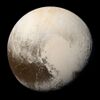Astronomy:(15874) 1996 TL66
| Discovery[1] | |
|---|---|
| Discovered by | D. C. Jewitt J. X. Luu J. Chen C. A. Trujillo |
| Discovery site | Mauna Kea Obs. |
| Discovery date | 9 October 1996 |
| Designations | |
| (15874) 1996 TL66 | |
| 1996 TL66 | |
| Minor planet category | TNO[2] · SDO[3] distant[4] |
| Orbital characteristics[2] | |
| Epoch 13 January 2016 (JD 2457400.5) | |
| Uncertainty parameter 2 | |
| Observation arc | 5883 days (16.11 yr) |
| |{{{apsis}}}|helion}} | 131.75 astronomical unit|AU (19.710 Tm) |
| |{{{apsis}}}|helion}} | 35.057 AU (5.2445 Tm) |
| 83.403 AU (12.4769 Tm) | |
| Eccentricity | 0.57967 |
| Orbital period | 761.70 yr (278211 d) |
| Mean anomaly | 6.8505° |
| Mean motion | 0° 0m 4.658s / day |
| Inclination | 24.006° |
| Longitude of ascending node | 217.82° |
| 184.79° | |
| Physical characteristics | |
| Mean diameter | 339±20 km[5] 575±115 km[6] |
| Rotation period | 12 h (0.50 d)[2] |
| Geometric albedo | 0.110+0.021 −0.015[5] 0.035+0.02 −0.01[6] |
| B–V = 0.687±0.072[7] V–R = 0.369±0.052[7] | |
| Apparent magnitude | 21[8] |
| Absolute magnitude (H) | 5.4[2] |
(15874) 1996 TL66 (provisional designation 1996 TL66) is a trans-Neptunian object of the scattered disc orbiting in the outermost region of the Solar System.[2][3]
The Spitzer Space Telescope has estimated this object to be about 575 kilometres (357 mi) in diameter,[6] but 2012 estimates from the Herschel Space Observatory estimate the diameter as closer to 339 kilometres (211 mi).[5] It is not a detached object, since its perihelion (closest approach to the Sun) is under the influence of Neptune.[3] Light-curve-amplitude analysis suggests that it is a spheroid.[9] Tancredi presents "in the form of a decision tree, the set of questions to be considered in order to classify an object as an icy 'dwarf planet'." They find that (15874) 1996 TL66 is very probably a dwarf planet.[10] Mike Brown's website, using a radiometrically determined diameter of 344 kilometres (214 mi), lists it as a possible dwarf planet.[11]
Discovery
Discovered in 1996 by David C. Jewitt et al., it was the first object to be categorized as a scattered-disk object (SDO), although (48639) 1995 TL8, discovered a year earlier, was later recognised as a scattered-disk object. It was considered one the largest known trans-Neptunian objects at the time of the discovery, being placed second after Pluto.[12] It came to perihelion in 2001.[2]
Orbit and size
(15874) 1996 TL66 orbits the Sun with a semi-major axis of 83.9 AU[2] but is currently only 35 AU from the Sun with an apparent magnitude of 21.[8] In 2007, the Spitzer Space Telescope estimated it to have a low albedo with a diameter of about 575±115 km.[6] More-recent measurements in 2012 by the 'TNOs are Cool' research project and reanalysis of older data have resulted in a new estimate of these figures.[5] It is now assumed that it has a higher albedo and the diameter was revised downward to 339±20 km. Light-curve-amplitude analysis shows only small deviations, suggesting (15874) 1996 TL66 is a spheroid with small albedo spots and may be a dwarf planet.[9]
References
- ↑ "MPEC 1997-B18: 1996 TL66". Minor Planet Center. 1997-01-30. https://www.minorplanetcenter.net/mpec/J97/J97B18.html. Retrieved 2011-07-05.
- ↑ Jump up to: 2.0 2.1 2.2 2.3 2.4 2.5 2.6 "JPL Small-Body Database Browser: 15874 (1996 TL66)". https://ssd.jpl.nasa.gov/sbdb.cgi?sstr=15874. Retrieved 5 April 2016.
- ↑ Jump up to: 3.0 3.1 3.2 Marc W. Buie (2006-07-30). "Orbit Fit and Astrometric record for 15874". SwRI (Space Science Department). http://www.boulder.swri.edu/~buie/kbo/astrom/15874.html. Retrieved 2009-01-22.
- ↑ "List Of Centaurs and Scattered-Disk Objects". Minor Planet Center. http://www.minorplanetcenter.org/iau/lists/Centaurs.html. Retrieved 2009-01-22.
- ↑ Jump up to: 5.0 5.1 5.2 5.3 Santos-Sanz, P. (2012). ""TNOs are Cool": A Survey of the Transneptunian Region IV. Size/albedo characterization of 15 scattered disk and detached objects observed with Herschel Space Observatory-PACS". Astronomy & Astrophysics 541: A92. doi:10.1051/0004-6361/201118541. Bibcode: 2012A&A...541A..92S.
- ↑ Jump up to: 6.0 6.1 6.2 6.3 John Stansberry; Will Grundy; Mike Brown; Dale Cruikshank; John Spencer; David Trilling; et al. (2007). "Physical Properties of Kuiper Belt and Centaur Objects: Constraints from Spitzer Space Telescope". arXiv:astro-ph/0702538.
- ↑ Jump up to: 7.0 7.1 Hainaut, O. R.; Boehnhardt, H.; Protopapa, S. (October 2012). "Colours of minor bodies in the outer solar system. II. A statistical analysis revisited". Astronomy and Astrophysics 546: 20. doi:10.1051/0004-6361/201219566. Bibcode: 2012A&A...546A.115H.
- ↑ Jump up to: 8.0 8.1 "AstDys (15874) 1996TL66 Ephemerides". Department of Mathematics, University of Pisa, Italy. https://newton.spacedys.com/astdys/index.php?pc=1.1.3.0&n=15874. Retrieved 2010-02-10.
- ↑ Jump up to: 9.0 9.1 Tancredi, G., & Favre, S. (2008) Which are the dwarfs in the Solar System?. Depto. Astronomía, Fac. Ciencias, Montevideo, Uruguay; Observatorio Astronómico Los Molinos, MEC, Uruguay. Retrieved 10-08-2011
- ↑ Tancredi, G. (2010). "Physical and dynamical characteristics of icy "dwarf planets" (plutoids)". Icy Bodies of the Solar System: Proceedings IAU Symposium No. 263, 2009 263: 173. doi:10.1017/S1743921310001717. Bibcode: 2010IAUS..263..173T.
- ↑ Michael E. Brown. "How many dwarf planets are there in the outer solar system? (updates daily)". California Institute of Technology. Archived from the original on 2011-10-18. https://web.archive.org/web/20111018154917/http://www.gps.caltech.edu/~mbrown/dps.html. Retrieved 2014-06-16.
- ↑ "1996 TO66 -- Another Large Transneptunian Object". Harvard-Smithsonian Center for Astrophysics. 19 June 1997. http://www.cbat.eps.harvard.edu/pressinfo/1996TO66.html. Retrieved 18 July 2020.
External links
- 1996 TL66 – A New Type of Transneptunian Object, MPC news release
- 1996 TL66 – A Newly Discovered Planetesimal
- Our Solar System Is Getting Crowded, Science Magazine
- 1996 TL66 – A New Dynamical Class in the Outer Solar System, David Jewitt's Kuiper Belt website
- Lists and Plots: Minor Planets
- (15874) 1996 TL66 at the JPL Small-Body Database
 |




